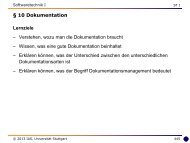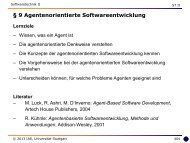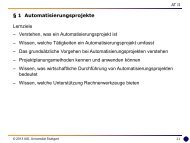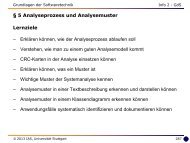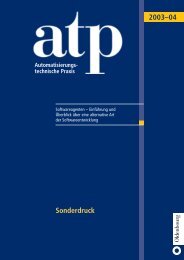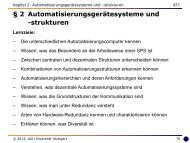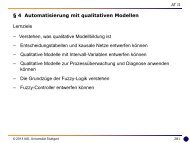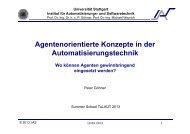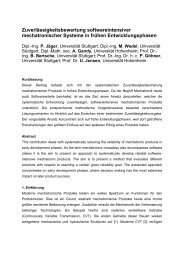Grundlagen FlexRay - Institut für Automatisierungs- und ...
Grundlagen FlexRay - Institut für Automatisierungs- und ...
Grundlagen FlexRay - Institut für Automatisierungs- und ...
Create successful ePaper yourself
Turn your PDF publications into a flip-book with our unique Google optimized e-Paper software.
<strong>Gr<strong>und</strong>lagen</strong> <strong>FlexRay</strong> BasicsV 1.1 32<br />
2.11 Communication structure<br />
The communication structure of a <strong>FlexRay</strong> bus is organized in Cycles. The duration of a<br />
Cycle is constant, and is defined by the parameter gdMacroPerCycle. The current active cycle<br />
is saved in vCycleCounter, it can be 0 to 63 ≡ cCycleCountMax.<br />
2.11.1 <strong>FlexRay</strong> Cycle<br />
Figure 2.28 shows <strong>FlexRay</strong> Cycles. Every Cycle is divided in four segments, which each have<br />
different properties.<br />
Static Segment:<br />
- Time-triggered transmission<br />
- Bus access using TDMA<br />
Dynamic Segment (optional):<br />
- Event-triggered Transmission<br />
- Bus access using FTDMA<br />
Symbol Window (optional):<br />
- Test symbol per Cycle for the use with a Bus Guardian<br />
NIT – Network Idle Time:<br />
- Segment for synchronization of the nodes<br />
Figure 2.28 Segments in a <strong>FlexRay</strong> cycle [VeSc11]<br />
The static segment is used for time-triggered data transfer, and is divided into slots, which are<br />
available and have to be used in every cycle. As bus access method TDMA is used, and<br />
therefore the defined access of the ECU to their slot(s) is guaranteed.<br />
In the dynamic segment, an event-triggered data transfer is possible. The length of the<br />
dynamic Slots may vary, and is implemented using the FTMDA method.<br />
The Symbol Window can be used to transmit test symbols, e.g. for the use with a bus<br />
guardian.<br />
The Network Idle Time is used by the nodes to perform the necessary time synchronization.<br />
Only the static segment and the Network Idle time are needed for a valid communication. The<br />
dynamic segment and the Symbol Window are optional. Therefore, there are four different<br />
possibilities for bus access.<br />
2.11.2 Bus access<br />
Depending on the application, the bus access can be configured flexibly. A <strong>FlexRay</strong> cluster<br />
can use either one of the modes shown in Figure 2.29.<br />
Bäurle 12.10.2012




